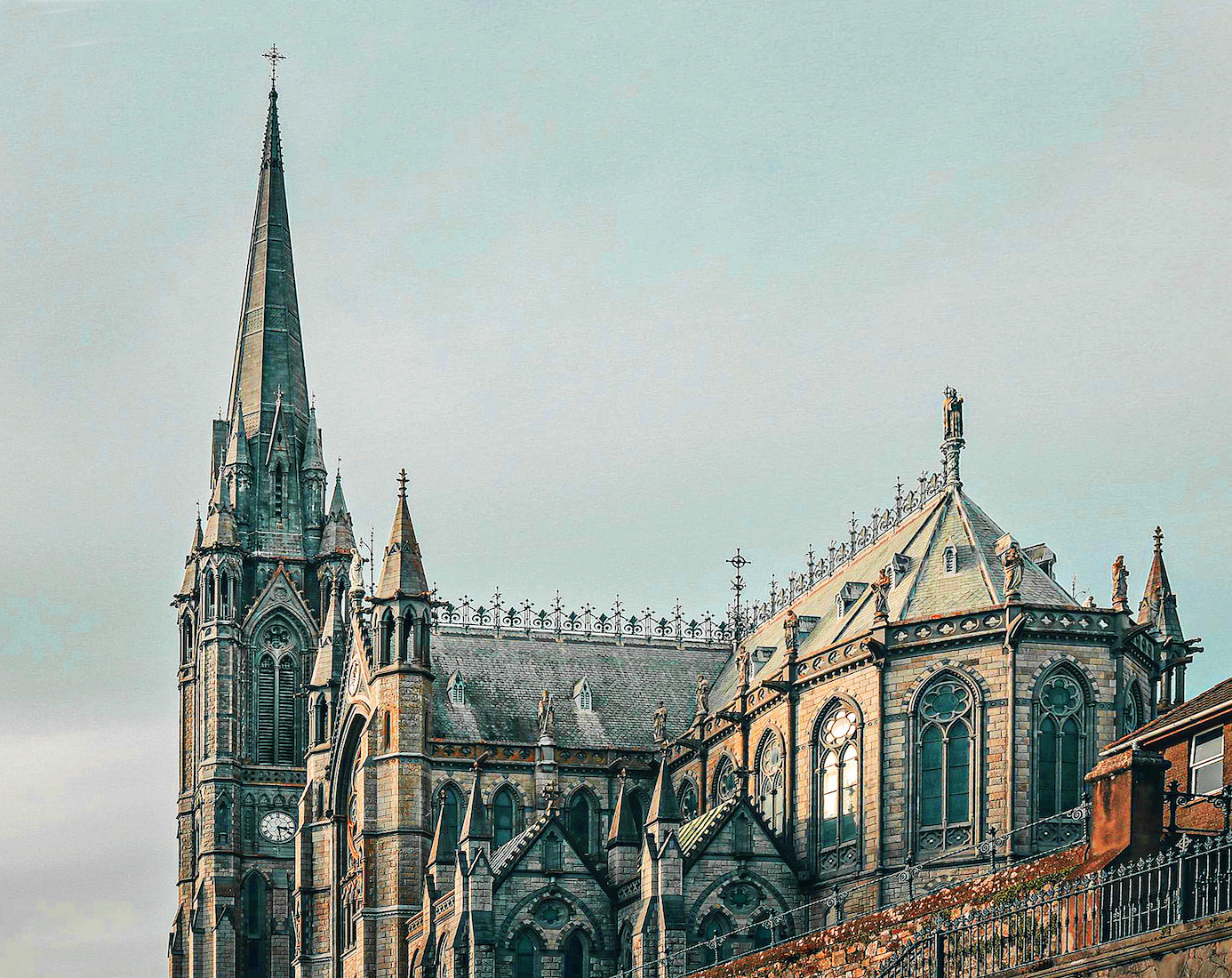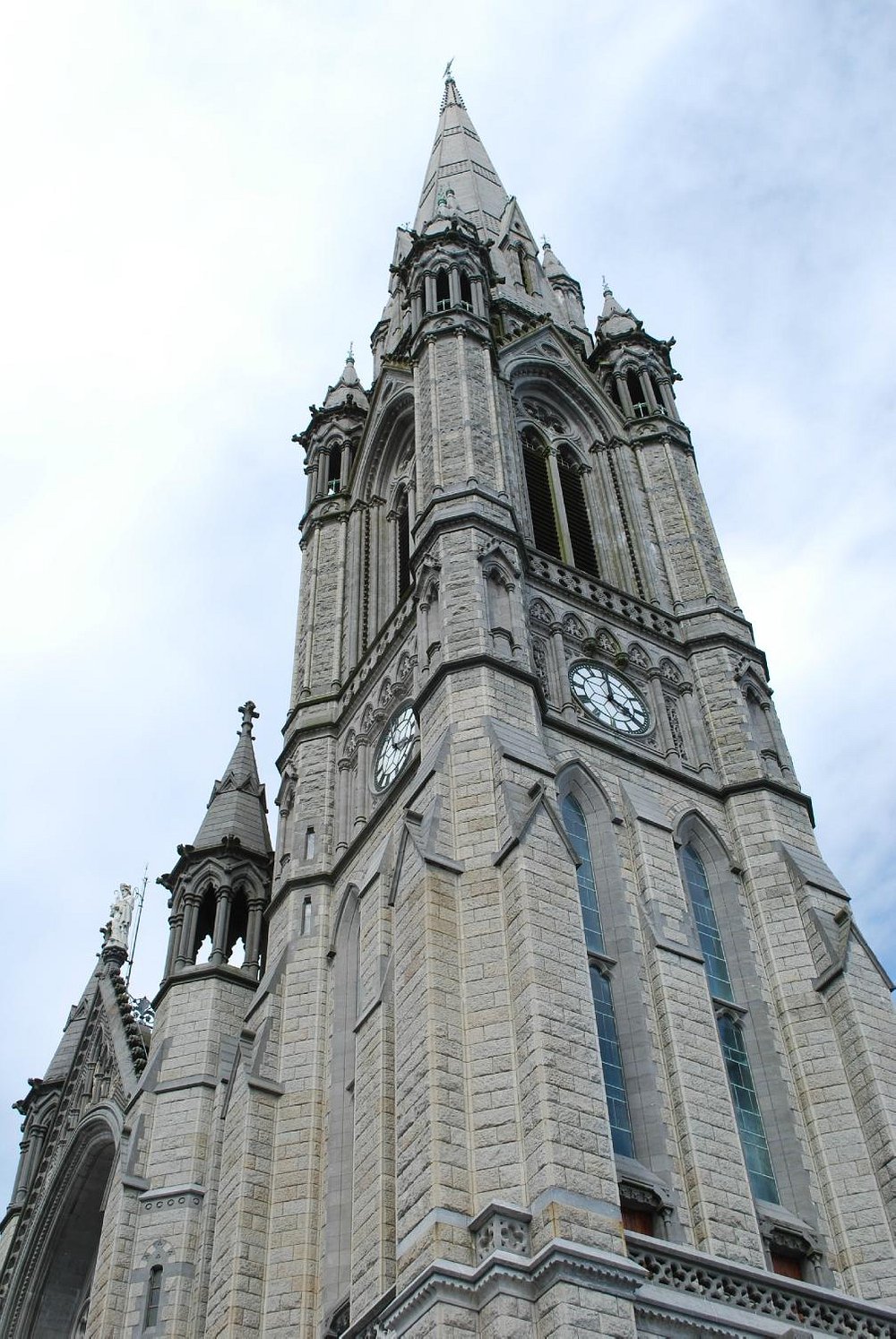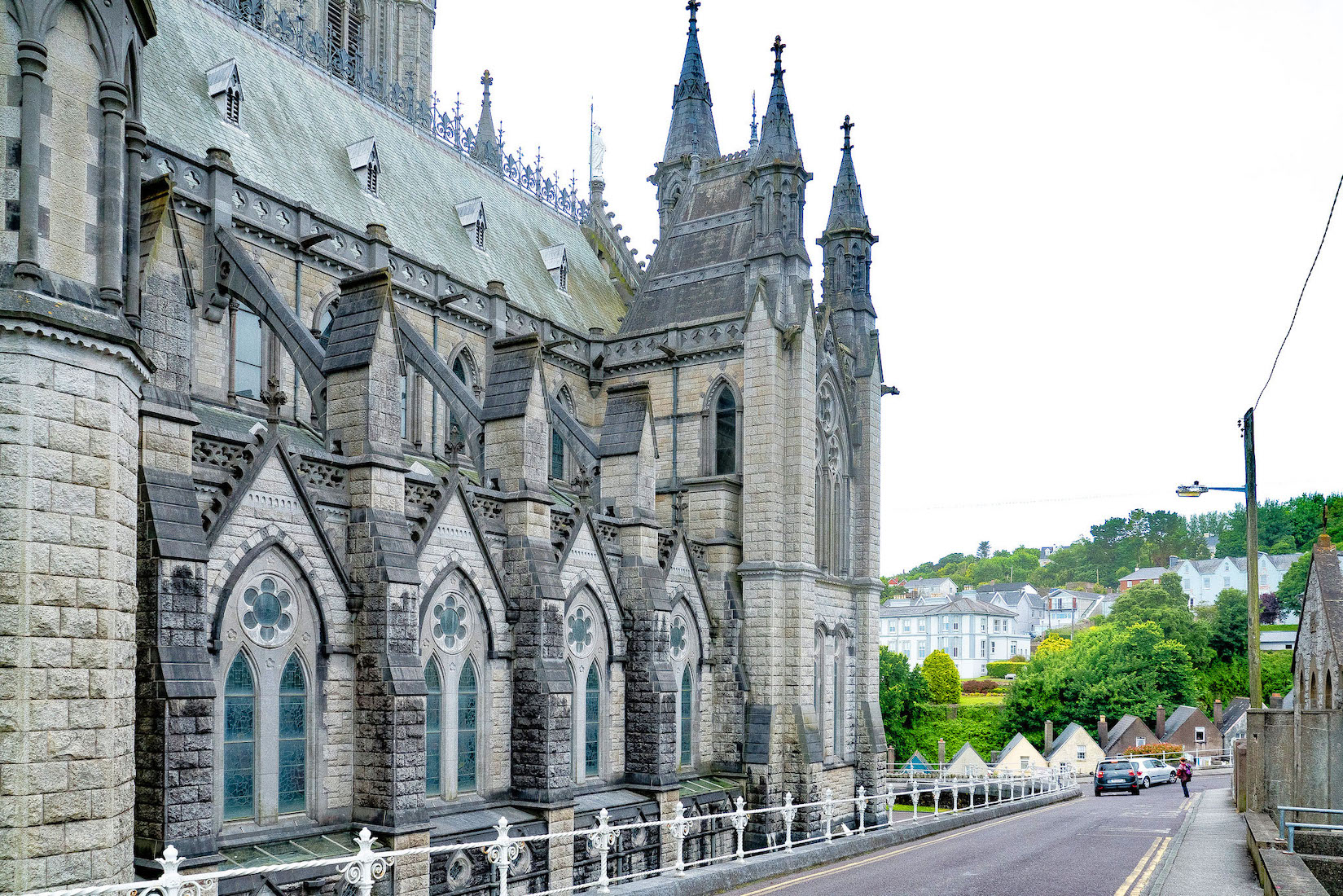
Cobh is a delightful town set on the shores of Cork Harbour in the south of Ireland. Colourful dwellings and shops line the waterfront, and behind, the neo-Gothic St Colman’s Cathedral rises grandly. We begin our exploration of Cobh Cathedral at the attractive local boat harbour. [Photo Credit: Geograph Marathon] INDEX
2. SOUTH WALL WM


As we draw closer, the South wall of the Cathedral appears to merge with the town buildings. In fact the Cathedral sits on top of a rise just behind the town. We make our way through to Rahilly Street which leads us directly to Cathedral Place which offers a steep climb! Even from here we can see that there are a great number of statues around the Cathedral roof. In particular, we see on the gable of the South transept, a statue of Mary with arms outstretched towards the town. [Photo2 Credit: Rachel Moorman]
3. CLIMBING THE HILL WM
We can follow up the road to the top bend, or take the flight of steps leading to the base of the Cathedral itself. We take the steps, of course!
4. VIEWS FROM BELOW TA DEA
Two views ... . From left the single tower and spire, the South transept, two Eastward extending chapels, and the sanctuary / apse. On top of the apse is a statue of St Colman. Saint Colman or Kolonat (Irish: Colmán; c. 600 – 689 AD) was an Irish-born Christian priest and missionary. He was beheaded while on mission in Würzburg, Germany. [Photo1 Credit: Anselmo E; Photo2 Credit: Pexels Dahlia E Akhaine]
5. SOUTHEAST VIEW TA
The Cathedral measures 65 metres long, 37.5 metres wide. The architectural style is Gothic Revival, modelled in particular in an elaborate French Gothic style. It is primarily constructed of blue Dalkey granite with Mallow limestone dressings. Dalkey Quarry is a long-disused 19th century granite quarry located in a suburb of Dublin. [Photo1 Credit: Tiger Tina301]
6. SOUTH TRANSEPT TA
The exterior of Cobh Cathedral has more than its fair share of gargoyles and statues! [Photo Credit: TA Tiger Tina301]
7. T0WER AND SPIRE TA
The square tower supports the octagonal limestone spire, with an impressive combined height of 90 metres, In addition there is a 3.3 metre bronze cross on top, making St. Colman’s the tallest cathedral in Ireland. The tower includes a 49-bell carillon, one of the largest in Europe. [Photo1 Credit: Tiger Tina301]
8. MEMORIAL STONES WM
I am intrigued by these two large square stones which lie in the grass alongside the South nave of the Cathedral . The nearer stone bears a consecrational cross and the symbol of a bishop’s mitre. So is this a burial site, or a consecrational memorial site?
9. HARBOUR VIEW
From the base of the Cathedral we can look out across the town of Cobh and appreciate the intricacies of the magnificent Cork harbour – one of the largest natural harbours in the world. [Photo Credit: Screen shot from Video]
10. WEST FACE AND CLOCK G-M TA
We come round the tower corner, and stop to admire the wonderful West face of St Colman’s Cathedral. Of special interest here is the (unknown) figure atop the central gable, and the interesting roofline in the Northwest (left) corner. There are three clock faces in the tower; the clock was installed in 1916. The tower contains Ireland’s only carillon, which with 49 bells is the most of any in the British Isles. It contains Ireland’s largest bell, named St Colman, which weighs 3.6 tons. Originally installed in 1916, the carillon was restored in 1998. The carillon chimes the quarter hours. There is also a mystery here.Just to the right of the central doors is a pair of buttresses with a single lower lancet window in between. We may have trouble finding it inside! [Photo1 Credit: Geograph Marathon; Photo2: TA JT3AZ]
11. NORTH NAVE WM
We walk around to the North side of the Cathedral, where we are now looking down on it. We observe the flying buttresses which are an essential feature of the the North and South sides of the building.
12. TOWARDS THE NORTH TRANSEPT WM
Walking to the East of the North transept, we now see the chapel which extends from the transept. We shall find that this is the St Thaddeus Chapel.
13. NORTHEAST CHAPELS WM
We particularly notice the open door here which leads to the Adoration Chapel. This is a simple chapel, open to the public, but used by a group of Benedictine nuns associated with the Cathedral. Here is a link about this.
14. ROOF DECORATIONS TA TA
This is a great place to enjoy the roof decorations: the many statues, and the elaborate wrought iron patterns. Someone must know the identity of these saintly figures! The roof is made of Belgian blue slate. [Photos Credit: TA Lisa L]
15. ADORATION CHAPEL WM
We complete our walk up Cathedral Place at this point where we look back on the Adoration Chapel.
16. VIEW FROM SANDYMOUNT DEA
Sandymount (Street) branches off at the sharp turn of Cathedral Place, and there is a good view of the West end of St Colman’s Cathedral from here. We notice the slit windows rising up the buttress on this side of the rose window, indicating a spiral staircase. There is one in the Southern buttress too. [Photo Credit: Pexels Dahlia E. Akhaine]
17. WEST DOORS SAB
We now approach the Cathedral more closely. Shown here are the main entry doors to the Cathedral (at right), and doors to the Baptistry (at left) [Photo Credit: See Around Britain]
18. BAPTISTRY DOOR WC
The baptistry doors feature some nice wrought iron lacework. Above the doors is a tympanum showing the Annunciation, when the Angel Gabriel appears to Mary with news of the impending birth of Jesus. [Photo Credits: Wikimedia Commons Andreas F Borchert]
19. MAIN WEST DOOR WC
The central entry doors also have a tympanum above, contained within a decorated crocketted gable. Alongside the doors, several carved figures welcome visitors to the Cathedral. A row of the twelve disciples stands above. [Photo Credit: Wikimedia Commons Andreas F Borchert]
20. WEST DOOR TYMPANUM JD
The central tympanum has a central mandorla with the Risen Christ holding the orb signifying his dominion over the earth in his left hand, and with right hand raised in a gesture of blessing. On either side are the symbols of the Four Evangelists: Matthew (angel), Mark (winged lion), Luke (winged ox) and John (eagle). [Photo Credit: Flickr Jim Driscoll]























